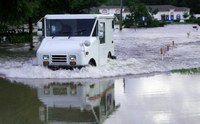Weather records due to climate change: A game with loaded dice
Posted on 1 April 2012 by John Hartz
This is a reprint of a press release posted by the Potsdam Institute for Climatic Impact Research on March 25, 2012.![]()
The past decade has been one of unprecedented weather extremes. Scientists of the Potsdam Institute for Climate Impact Research (PIK) in Germany argue that the high incidence of extremes is not merely accidental. From the many single events a pattern emerges. At least for extreme rainfall and heat waves the link with human-caused global warming is clear, the scientists show in a new analysis of scientific evidence in the journal Nature Climate Change. Less clear is the link between warming and storms, despite the observed increase in the intensity of hurricanes.

Flooded road after heavy rains in the US.
In 2011 alone, the US was hit by 14 extreme weather events which caused damages exceeding one billion dollars each – in several states the months of January to October were the wettest ever recorded. Japan also registered record rainfalls, while the Yangtze river basin in China suffered a record drought. Similar record-breaking events occurred also in previous years. In 2010, Western Russia experienced the hottest summer in centuries, while in Pakistan and Australia record-breaking amounts of rain fell. 2003 saw Europe´s hottest summer in at least half a millennium. And in 2002, the weather station of Zinnwald-Georgenfeld measured more rain in one day than ever before recorded anywhere in Germany – what followed was the worst flooding of the Elbe river for centuries.
"A question of probabilities"
“The question is whether these weather extremes are coincidental or a result of climate change,” says Dim Coumou, lead author of the article. “Global warming can generally not be proven to cause individual extreme events – but in the sum of events the link to climate change becomes clear.” This is what his analysis of data and published studies shows. “It is not a question of yes or no, but a question of probabilities,” Coumou explains. The recent high incidence of weather records is no longer normal, he says.
“It´s like a game with loaded dice,” says Coumou. “A six can appear every now and then, and you never know when it happens. But now it appears much more often, because we have changed the dice.” The past week illustrates this: between March 13th and 19th alone, historical heat records were exceeded in more than a thousand places in North America.
Three pillars: basic physics, statistical analysis and computer simulations
The scientists base their analysis on three pillars: basic physics, statistical analysis and computer simulations. Elementary physical principles already suggest that a warming of the atmosphere leads to more extremes. For example, warm air can hold more moisture until it rains out. Secondly, clear statistical trends can be found in temperature and precipitation data, the scientists explain. And thirdly, detailed computer simulations also confirm the relation between warming and records in both temperature and precipitation.
With warmer ocean temperatures, tropical storms – called typhoons or hurricanes, depending on the region – should increase in intensity but not in number, according to the current state of knowledge. In the past decade, several record-breaking storms occurred, for example hurricane Wilma in 2004. But the dependencies are complex and not yet fully understood. The observed strong increase in the intensity of tropical storms in the North Atlantic between 1980 and 2005, for example, could be caused not just by surface warming but by a cooling of the upper atmosphere. Furthermore, there are questions about the precision and reliability of historic storm data.
Overall, cold extremes decrease with global warming, the scientists found. But this does not compensate for the increase in heat extremes.
Climatic warming can turn an extreme event into a record-breaking event
“Single weather extremes are often related to regional processes, like a blocking high pressure system or natural phenomena like El Niño,“ says Stefan Rahmstorf, co-author of the article and chair of the Earth System Analysis department at PIK. “These are complex processes that we are investigating further. But now these processes unfold against the background of climatic warming. That can turn an extreme event into a record-breaking event.”
Journal Article: Coumou, D., Rahmstorf, S. (2012): A Decade of Weather Extremes. Nature Climate Change [DOI: 10.1038/NCLIMATE1452]































 Arguments
Arguments























 0
0  0
0 This increase does not take into account the effects of uplift or subsidence in North America due to isostatic rebound in North America. Consequently, while collapse fo the WAIS will bring 1.25 times global averge sea level rise in New York, it will bring much more south of New York along the US coast.
Still, Bamber et al is good news, on balance, as it reduces the expected sea level rise from a collapse of the WAIS. That does not reduce the final sea level rise expected from global warming as the ice expected to melt has not reduced, only the ice expected to collapse. But it does reduce the magnitude of the most rapid sea level rise.
This increase does not take into account the effects of uplift or subsidence in North America due to isostatic rebound in North America. Consequently, while collapse fo the WAIS will bring 1.25 times global averge sea level rise in New York, it will bring much more south of New York along the US coast.
Still, Bamber et al is good news, on balance, as it reduces the expected sea level rise from a collapse of the WAIS. That does not reduce the final sea level rise expected from global warming as the ice expected to melt has not reduced, only the ice expected to collapse. But it does reduce the magnitude of the most rapid sea level rise.







Comments